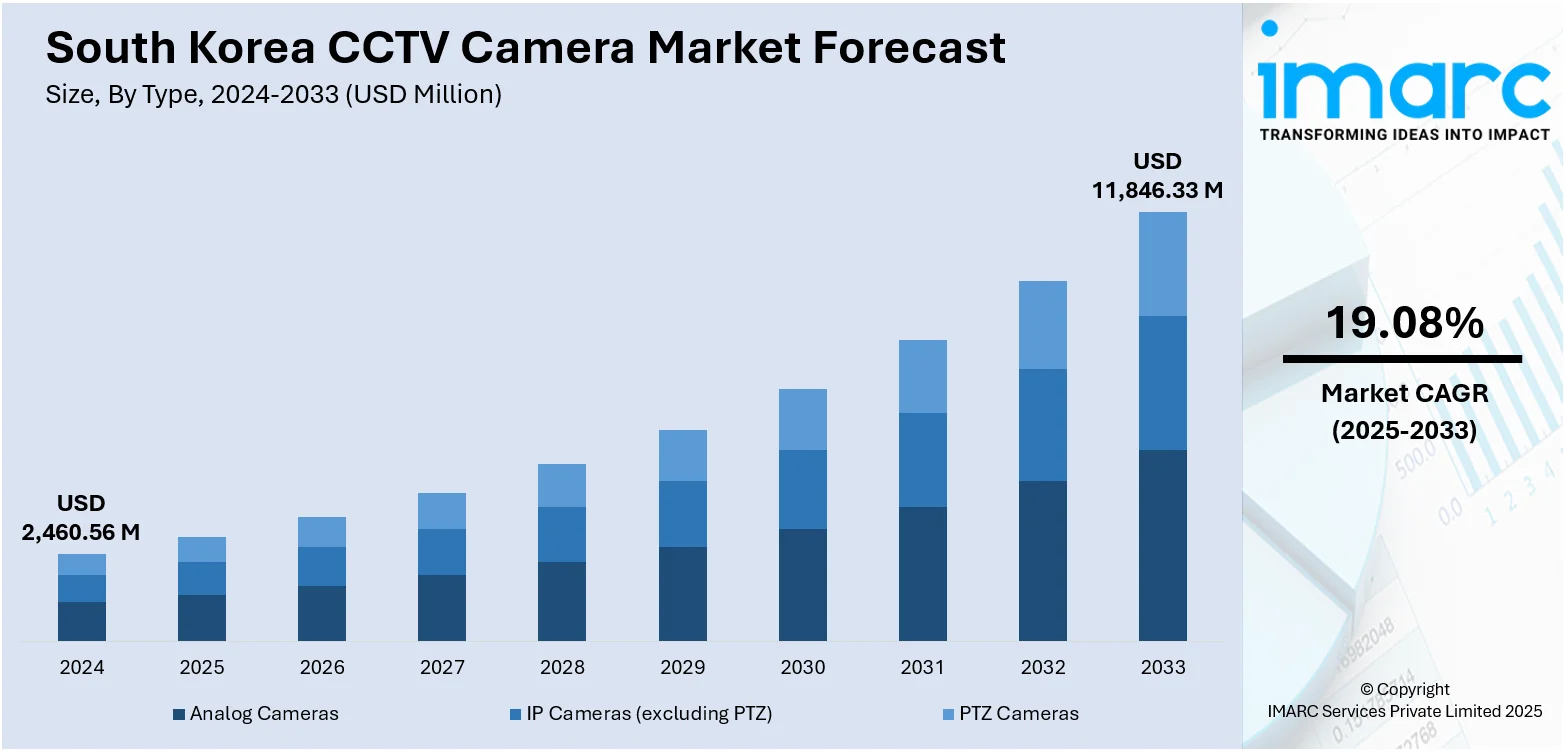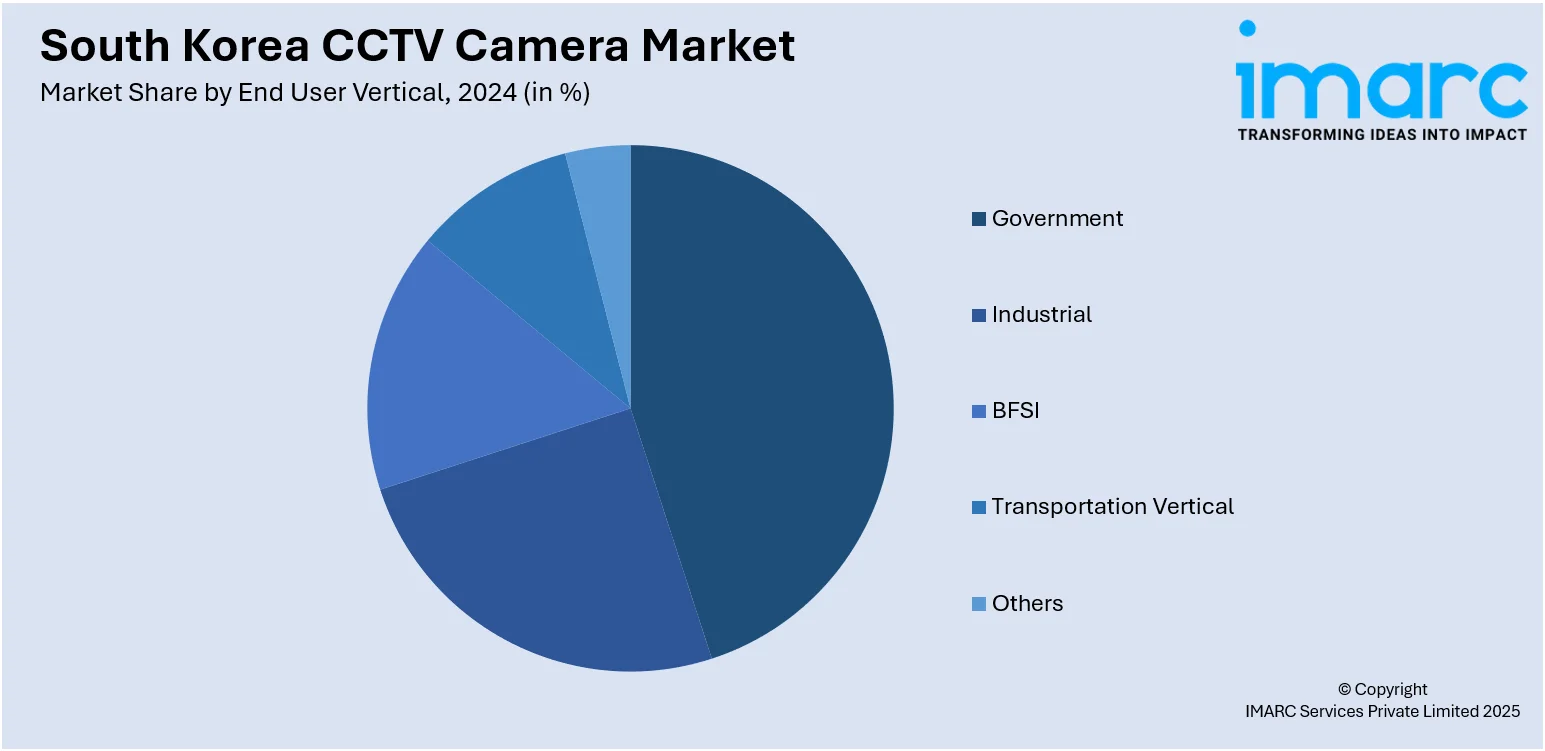
South Korea CCTV Camera Market Size, Share, Trends and Forecast by Type, End User Vertical, and Region, 2025-2033
South Korea CCTV Camera Market Overview:
The South Korea CCTV camera market size reached USD 2,460.56 Million in 2024. Looking forward, the market is expected to reach USD 11,846.33 Million by 2033, exhibiting a growth rate (CAGR) of 19.08% during 2025-2033. The market is witnessing robust growth driven by heightened security concerns, smart city initiatives, and widespread adoption of AI-enabled surveillance technologies. Demand is rising across commercial, residential, and public sectors, with a strong emphasis on real-time monitoring and data analytics. Technological advancements and government-led safety programs continue to fuel expansion, contributing significantly to the evolving South Korea CCTV camera market share.
|
Report Attribute
|
Key Statistics
|
|---|---|
|
Base Year
|
2024
|
|
Forecast Years
|
2025-2033
|
|
Historical Years
|
2019-2024
|
| Market Size in 2024 | USD 2,460.56 Million |
| Market Forecast in 2033 | USD 11,846.33 Million |
| Market Growth Rate 2025-2033 | 19.08% |
South Korea CCTV Camera Market Trends:
AI-Powered Surveillance
Increasing use of artificial intelligence in surveillance equipment is majorly driving market growth. AI-enabled cameras now come with sophisticated capabilities such as facial recognition, license plate reading (LPR), object detection, and behavioral analysis. All these help in identifying incidents faster, automating notifications, and intelligent video management making the surveillance process more proactive. For instance, facial recognition helps detect individuals in crowded places, and LPR technology helps in effective traffic regulation and enforcement. In addition, behavioral analytics can identify irregular movement behavior thus reducing the likelihood of security threats. For instance, in September 2024, Korean researchers from the Electronics and Telecommunications Research Institute developed "Dejaview" an AI-driven CCTV technology that detects and predicts criminal activities in real time. By analyzing past crime patterns and current environmental factors this system aims to prevent crimes enhancing surveillance capabilities for police and local governments. These intelligent systems are increasingly utilized across public infrastructure, retail, and transportation sectors, where security and operational efficiency are critical. As AI technology continues to become more accessible and affordable, its use within the CCTV industry is rapidly growing, contributing significantly to the ongoing South Korea CCTV camera market growth.

To get more information on this market, Request Sample
Public Safety and Transport Focus
The focus on public safety and transport security is crucial for the growth of the South Korea CCTV camera market. Authorities are emphasizing the deployment of advanced surveillance systems within metro stations, bus depots, public parks, and important government facilities to deter criminal activity, monitor behaviors, and facilitate quick emergency responses. For instance, in January 2024, Seoul announced plans to enhance public safety by adding 10,000 AI surveillance cameras in parks and hiking trails by 2026. These cameras will help identify dangers and send real-time alerts to emergency services. Additionally, outdated cameras will be replaced, with a budget of 126.5 billion won allocated for upgrades. In bustling areas such as transit hubs, CCTV cameras aid in managing crowds, identifying suspicious actions, and enabling real-time oversight for better operational effectiveness. Government buildings and public parks are increasingly outfitted with surveillance technologies to improve situational awareness and safeguard citizens. These initiatives are in line with South Korea’s larger strategy to create safer urban spaces, particularly in densely populated regions. As the appetite for smart, high-resolution, and networked cameras increases, ongoing public safety endeavors continue to drive steady investment in the evolving video surveillance sector of the country.
South Korea CCTV Camera Market Segmentation:
IMARC Group provides an analysis of the key trends in each segment of the market, along with forecasts at the country and regional levels for 2025-2033. Our report has categorized the market based on type and end user vertical.
Type Insights:
- Analog Cameras
- IP Cameras (excluding PTZ)
- PTZ Cameras
The report has provided a detailed breakup and analysis of the market based on the type. This includes analog cameras, IP cameras (excluding PTZ), and PTZ cameras.
End User Vertical Insights:

- Government
- Industrial
- BFSI
- Transportation Vertical
- Others
A detailed breakup and analysis of the market based on the end user vertical have also been provided in the report. This includes government, industrial, BFSI, transportation vertical, and others.
Regional Insights:
- Seoul Capital Area
- Yeongnam (Southeastern Region)
- Honam (Southwestern Region)
- Hoseo (Central Region)
- Others
The report has also provided a comprehensive analysis of all the major regional markets, which include Seoul Capital Area, Yeongnam (Southeastern Region), Honam (Southwestern Region), Hoseo (Central Region), and others.
Competitive Landscape:
The market research report has also provided a comprehensive analysis of the competitive landscape. Competitive analysis such as market structure, key player positioning, top winning strategies, competitive dashboard, and company evaluation quadrant has been covered in the report. Also, detailed profiles of all major companies have been provided.
South Korea CCTV Camera Market Report Coverage:
| Report Features | Details |
|---|---|
| Base Year of the Analysis | 2024 |
| Historical Period | 2019-2024 |
| Forecast Period | 2025-2033 |
| Units | Million USD |
| Scope of the Report |
Exploration of Historical Trends and Market Outlook, Industry Catalysts and Challenges, Segment-Wise Historical and Future Market Assessment:
|
| Types Covered | Analog Cameras, IP Cameras (excluding PTZ), PTZ Cameras |
| End User Verticals Covered | Government, Industrial, BFSI, Transportation Vertical, Others |
| Regions Covered | Seoul Capital Area, Yeongnam (Southeastern Region), Honam (Southwestern Region), Hoseo (Central Region), Others |
| Customization Scope | 10% Free Customization |
| Post-Sale Analyst Support | 10-12 Weeks |
| Delivery Format | PDF and Excel through Email (We can also provide the editable version of the report in PPT/Word format on special request) |
Key Questions Answered in This Report:
- How has the South Korea CCTV camera market performed so far and how will it perform in the coming years?
- What is the breakup of the South Korea CCTV camera market on the basis of type?
- What is the breakup of the South Korea CCTV camera market on the basis of end user vertical?
- What is the breakup of the South Korea CCTV camera market on the basis of region?
- What are the various stages in the value chain of the South Korea CCTV camera market?
- What are the key driving factors and challenges in the South Korea CCTV camera market?
- What is the structure of the South Korea CCTV camera market and who are the key players?
- What is the degree of competition in the South Korea CCTV camera market?
Key Benefits for Stakeholders:
- IMARC’s industry report offers a comprehensive quantitative analysis of various market segments, historical and current market trends, market forecasts, and dynamics of the South Korea CCTV camera market from 2019-2033.
- The research report provides the latest information on the market drivers, challenges, and opportunities in the South Korea CCTV camera market.
- Porter's five forces analysis assist stakeholders in assessing the impact of new entrants, competitive rivalry, supplier power, buyer power, and the threat of substitution. It helps stakeholders to analyze the level of competition within the South Korea CCTV camera industry and its attractiveness.
- Competitive landscape allows stakeholders to understand their competitive environment and provides an insight into the current positions of key players in the market.
Need more help?
- Speak to our experienced analysts for insights on the current market scenarios.
- Include additional segments and countries to customize the report as per your requirement.
- Gain an unparalleled competitive advantage in your domain by understanding how to utilize the report and positively impacting your operations and revenue.
- For further assistance, please connect with our analysts.
 Request Customization
Request Customization
 Speak to an Analyst
Speak to an Analyst
 Request Brochure
Request Brochure
 Inquire Before Buying
Inquire Before Buying




.webp)




.webp)












